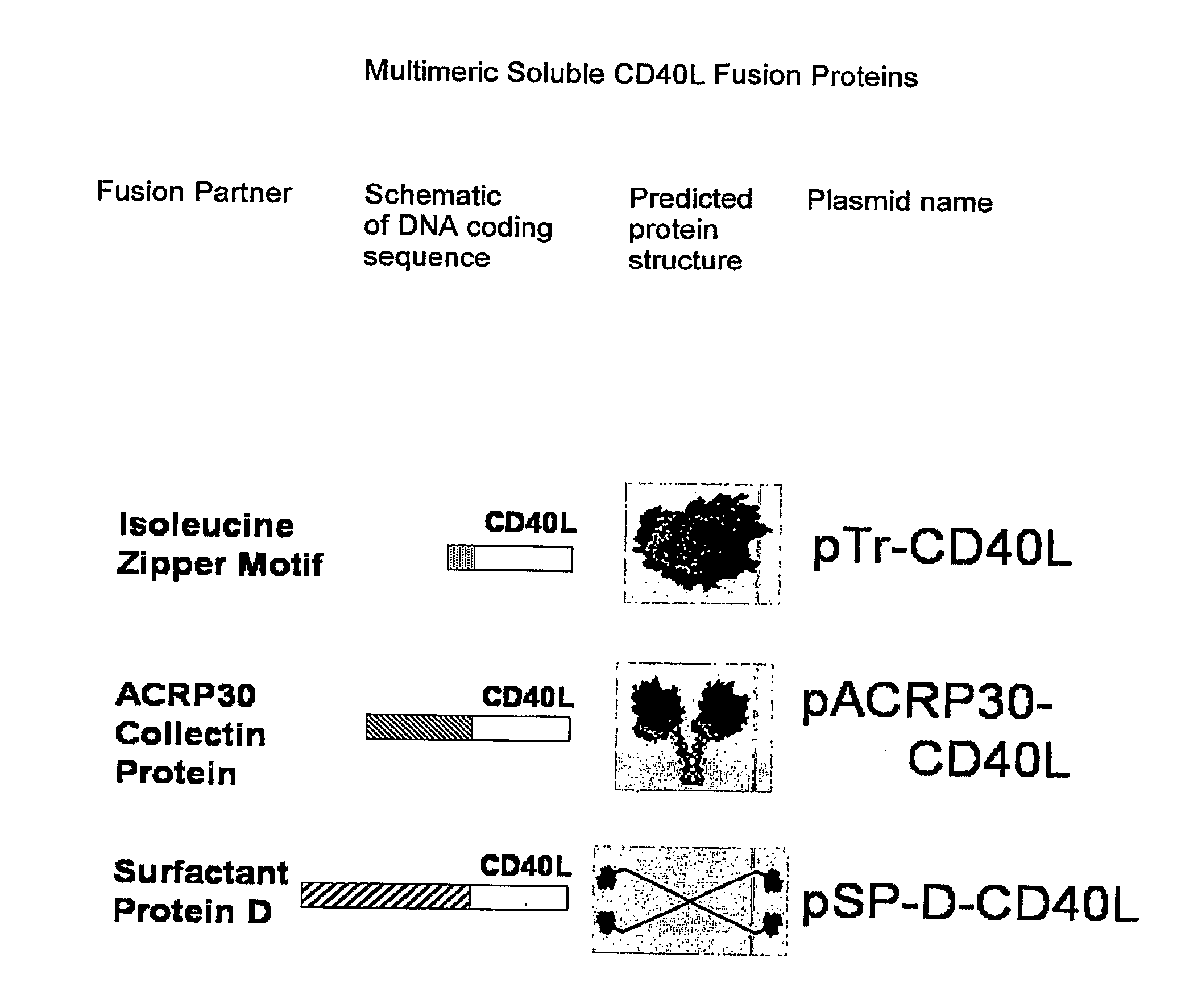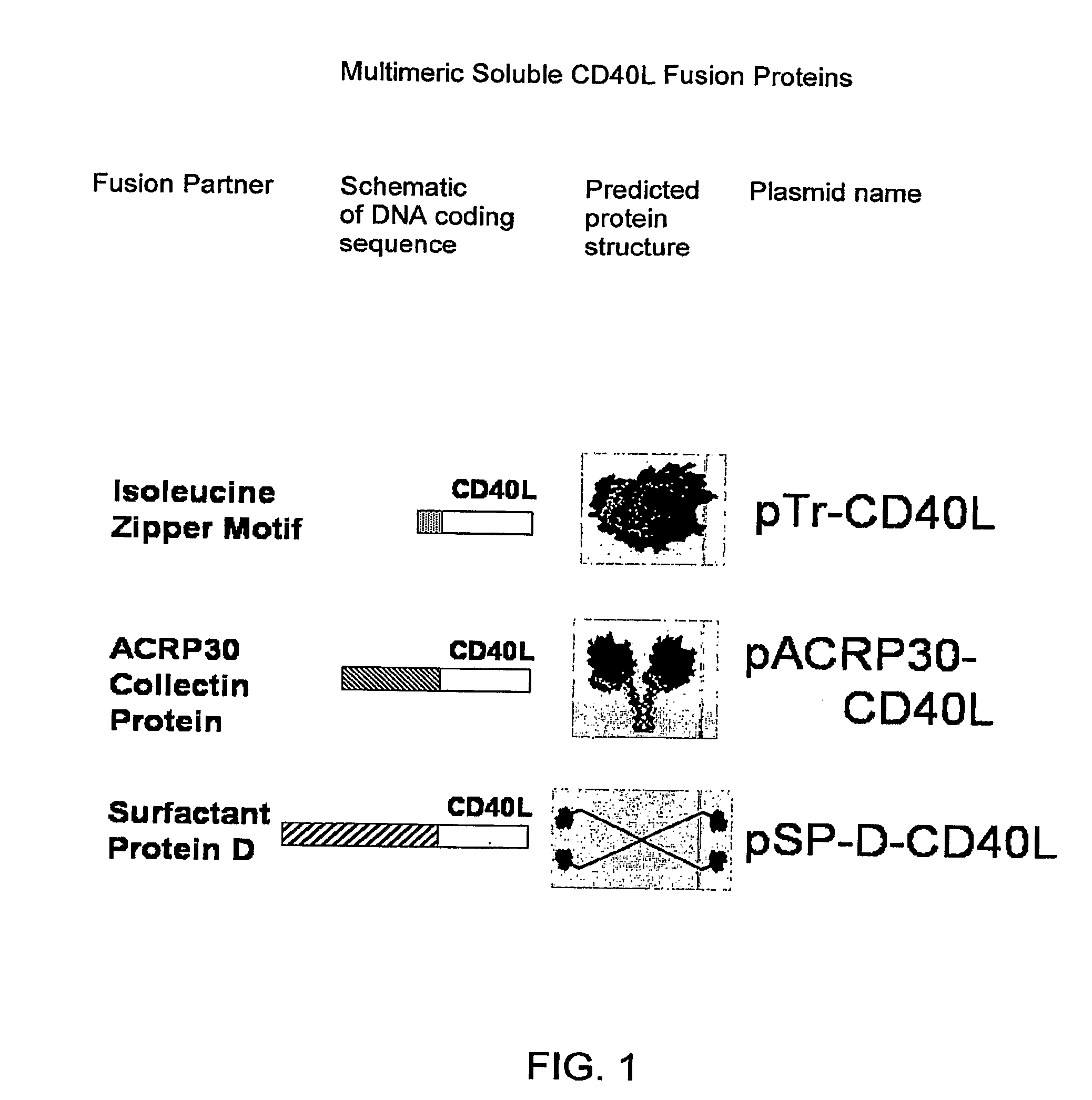Immunostimulatory Combinations for Vaccine Adjuvants
- Summary
- Abstract
- Description
- Claims
- Application Information
AI Technical Summary
Benefits of technology
Problems solved by technology
Method used
Image
Examples
example 1
Plasmid Construction
[0228]Plasmids were constructed in the pcDNA3.1 expression vector (Invitrogen, Carlsbad, Calif.). Membrane CD40L (p-Mem-CD40L), the full-length natural form of murine CD40L, was cloned by RT-PCR from antiCD3 / anti-CD 26-stimulated murine spleen cells.
[0229]1-trimer soluble CD40L (pTr-CD40L) was constructed using PCR resulting in an isoleucine zipper fused to the extracellular domain of murine CD40L (including the stalk). The construct was subsequently cloned into the pcDNA3.1 expression vector (FIG. 1).
[0230]For the 2-trimer soluble CD40L (pAcrp30-CD40L), the body of murine Acrp30 was fused to the extracellular domain of murine CD40L. Acrp30 is a V-shaped molecule with two trimeric arms that can present two trimeric TNFSF extracellular domains (FIG. 1).
[0231]For the 4-trimer soluble CD40L, and GITRL (pSP-D-CD40L and pSP-D-GITRL), the body of murine surfactant protein D (SP-D) was fused to the extracellular domains of murine CD40L or GITRL (including their stalks)....
example 2
Soluble, Multimeric CD40L and GIRTL as DNA Vaccine Adjuvants
[0244]The 4-trimer soluble CD40L dramatically enhances the cytotoxic CD8+ T cell responses to a DNA vaccine (FIG. 2). As found by others, the addition of a plasmid for full-length membrane CD40L (pMemCD40L) had no enhancing effects. In contrast, a plasmid for 4-trimer soluble CD40L (pSP-D-CD40L) dramatically increased the CTL response to Gag compared to 2-trimer and 1-trimer forms.
[0245]The addition of a 4-trimer soluble GITRL to DNA vaccination significantly increased CTLs (FIG. 3). However, these CD8+ T cell responses were not as strong as those produced using 4-trimer CD40L as a molecular adjuvant.
example 3
Tumor Immunotherapy Methods
[0246]BALB / c mice were injected with 1×106 A 20 tumor cells s.c. and C57B5 / 6 mice were injected with 1×106 B16-F10 tumor cells s.c. After a palpable tumor appeared (>4 mm), 50 μl PBS or plasmid DNA (50 μg) with or without TLR agonist molecules was injected into and around the tumors every other day×5. Tumors were measured every other day. Mice were sacrificed when they showed signs of stress or tumors became larger than 1.5 cm×1.5 cm.
[0247]Cure of an Established A20 Lymphoma Tumor by Peri-Tumoral Plasmid Injections.
[0248]For A20 lymphoma tumors, plasmids for non-secreted membrane CD40L (pMemCD40L), 2-trimer soluble CD40L (pAcrp30-CD40L), 4-trimer soluble CD40L (pSP-D-CD40L) and 4-trimer soluble GITRL (pSP-D-GITRL) were injected. All of these plasmids used the pcDNA3.1 vector. All three soluble multimeric TNFSF plasmids had anti-tumor activity, and in 4 / 5 cases were able to cure mice of local tumors (FIG. 4). The plasmid for membrane CD40L (pMemCD40L) was i...
PUM
| Property | Measurement | Unit |
|---|---|---|
| Electrical conductance | aaaaa | aaaaa |
| Composition | aaaaa | aaaaa |
| Immunostimulation | aaaaa | aaaaa |
Abstract
Description
Claims
Application Information
 Login to View More
Login to View More - R&D
- Intellectual Property
- Life Sciences
- Materials
- Tech Scout
- Unparalleled Data Quality
- Higher Quality Content
- 60% Fewer Hallucinations
Browse by: Latest US Patents, China's latest patents, Technical Efficacy Thesaurus, Application Domain, Technology Topic, Popular Technical Reports.
© 2025 PatSnap. All rights reserved.Legal|Privacy policy|Modern Slavery Act Transparency Statement|Sitemap|About US| Contact US: help@patsnap.com



